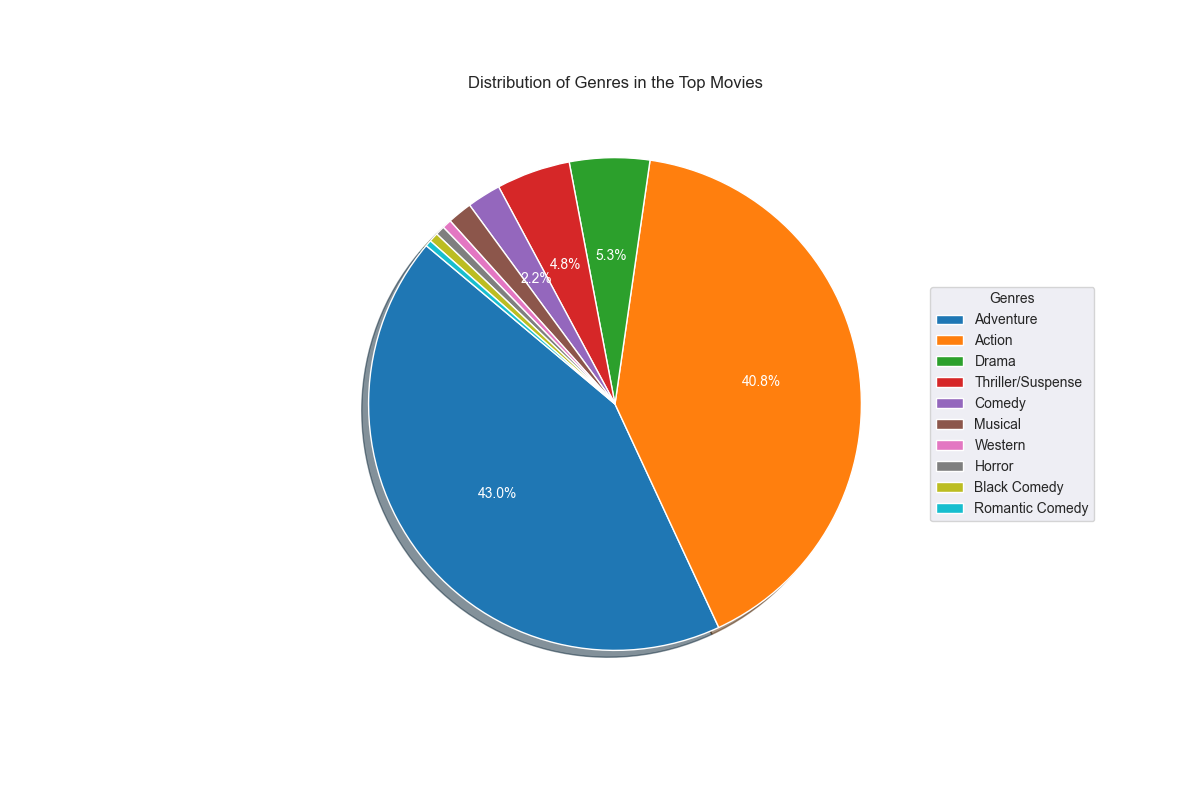Behind the Silver Screen: Analyzing the Top 500 Movie Budgets

1. Overview
From Superheroes to Wizards: The Movies with the Biggest Budgets
When it comes to the film industry, money can be a game-changer. From creating breathtaking visual effects to hiring the best in the industry, a movie's budget often signifies the scale and ambition of the project. In this post, we're diving into the budgets of some of the most notable movies ever made, understanding the distribution of genres and how the money was distributed across these cinematic gems.
Let's dive into the numbers and unveil the financial landscape of the biggest films in history.

- Action and Adventure Reign Supreme: A combined total of over 80% for Action and Adventure genres indicates a clear preference for high-octane and thrilling content among audiences and studios. These genres, known for spectacular visuals, thrilling sequences, and expansive worlds, often require bigger budgets, but they promise high returns.
- Diverse Tastes: While the Action and Adventure genres dominate, there is still a significant audience for Drama, Thriller/Suspense, and Comedy, ensuring a varied cinematic landscape.
- Niche Genres: Musical, Western, and Horror occupy smaller slices of the pie, suggesting either niche appeal or perceived risk in big-budget ventures for these genres.

It's evident that creating cinematic masterpieces comes with a hefty price tag. Topping the list is "Avengers: Endgame" with an astronomical budget of 400 million dollars. This blockbuster is closely followed by movies from franchises known for their grandeur, visual effects, and ensemble casts.
Many movies on this list belong to established franchises, suggesting that studios are willing to invest heavily when there's an established fan base and a proven track record.
2. Yearly Insights
Cinema, has transformed dramatically with advancements in technology, storytelling techniques, and audience preferences. With these changes, the budgets allocated to movies have witnessed significant shifts. As the old saying goes, "You've got to spend money to make money," but how does this adage apply to the world of big-budget films over the years?

Insights:
- The 2000-2010 Surge: The graph clearly underscores a significant uptick in production costs from the start of the millennium leading up to 2010. This can be attributed to the golden age of blockbusters where high-risk, high-reward projects seemed to pay off.
- The Pandemic Effect: The grip of the COVID-19 pandemic on global industries is evident, with the film industry being no exception. The sizable dip in 2020 serves as a stark reminder of the industry's vulnerability to global events. The movie budgets took a hit, perhaps due to the uncertainties surrounding theatre releases and changing consumer behavior with a significant shift to streaming platforms.
- The Post-pandemic Landscape: As we steer clear of the tumultuous pandemic years, the graph hints at a recovery, albeit not as vigorous as the pre-pandemic era. The industry seems cautious, with budgets being substantial but not reaching the highs of the past. It remains to be seen if this is a temporary setback or a recalibration of the industry's approach to big-budget films.
As we delve deeper into the numbers, it becomes evident that the world of cinema is not just about art but also a strategic play of investments. The ever-rising costs of films reflect filmmakers' confidence in their content, betting big on the audience's reception. With streaming platforms also entering the fray, the future of movie budgets and their returns will be an exciting space to watch.
3. Top Grossing vs. Production Cost
In the realm of motion pictures, it's a question as old as the industry itself: does a bigger investment necessarily translate to a larger return? There's an allure to the spectacle of a blockbuster – grand visuals, star-studded casts, and promotional blitzes that leave no stone unturned. But when the credits roll and the box office numbers come in, does that hefty production price tag guarantee box office gold?

This reveals an interesting story: while there's a general upward trend indicating that films with higher production costs tend to earn more at the box office, there are notable exceptions. Not every high-budget film guarantees a billion-dollar box office collection. Some movies, like 'Avengers: Endgame', had phenomenal success, generating returns many times their investment. On the other hand, some films, despite their massive production budgets, saw only moderate box office success.
The cinema industry, much like others, does not offer sure-shot formulas for success. While massive budgets can bring in state-of-the-art visual effects and A-list stars, the essence of storytelling, emotional connection, and market dynamics all play a pivotal role in a movie's success.
4. Runtime
In the vast world of cinema, numerous factors can impact the reception of a film - the plot, the actors, the cinematography, and even the runtime. Delving into the data behind movie runtimes can offer a plethora of insights.

From our analysis, 115 minutes (or 1 hour and 55 minutes) has emerged as the most frequently occurring runtime for movies. This suggests that filmmakers and studios have found a sweet spot around this duration. The reasons could be multifaceted:
- Audience Retention: Movies that are too short might feel rushed, while overly long films can lead to audience fatigue. A runtime close to 2 hours could offer the right balance, providing ample time for plot development without overextending the audience's attention span.
- Box Office Strategy: A runtime hovering around 2 hours can maximize the number of daily showtimes in theaters, potentially leading to higher box office revenues.
The apparent normal distribution pattern, with 115 minutes at its core, hints at an industry preference that aligns with audience preferences, logistical considerations, and perhaps even storytelling necessities. As with all art forms, the beauty of cinema lies in both its patterns and its exceptions.
5. Hits and Misses
A big budget doesn't always guarantee success. Production houses invest millions, sometimes even billions, in creating a masterpiece, but the box office can be unpredictable. Let's unravel this mystery and take a look at some of the movies that, despite their hefty price tags, failed to set the box office on fire, and some that defied expectations and massively over-performed.

The film industry's unpredictability can be staggering. While some films with enormous budgets underperform, others manage to gain immensely more than their investment.
6. Conclusion: The Box Office Dance
The cinematic universe is not just about breathtaking visuals, star-studded casts, or compelling narratives. It's a dance of numbers - budgets, revenues, screenings, and runtimes. Some movies, irrespective of their budgets, resonate with audiences worldwide, translating to massive box office collections. At the same time, others may not hit the expected mark.
As film enthusiasts, critics, or even as curious data analyzers, diving into these numbers provides a fresh perspective on movies. Beyond the glitz and glamour, there's a tale of expectations, risks, returns, and sometimes, unforeseen surprises. And isn't that what makes the world of movies so incredibly fascinating?